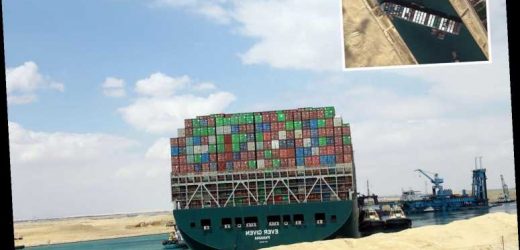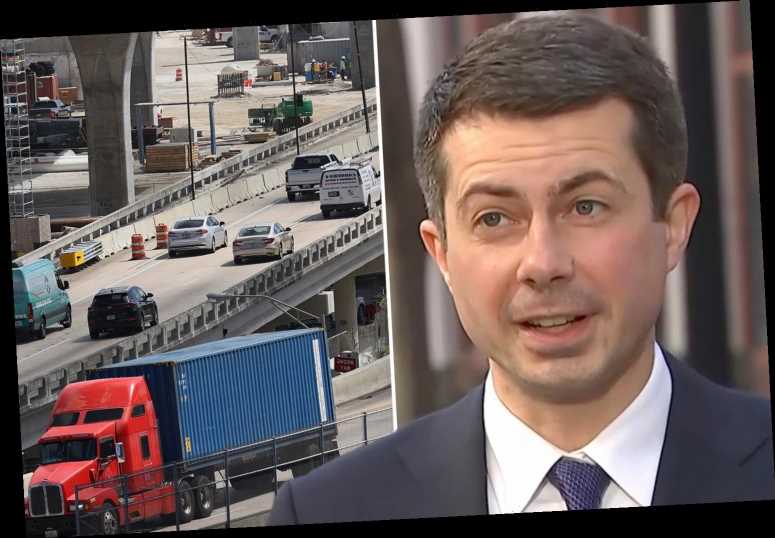THE CARGO ship stranded in the Suez Canal MOVED for the first time in days – but it could be trapped until next week.
Panama-flagged The Ever Given smashed into the banks of the Canal five days ago and halted the global trade route – and a "human error" may have caused the crash.
?Follow our Suez Canal live blog for all the latest news and updates
Head of the Suez Canal Authority, Osama Rabei, said today that people are working around the clock to free the ship – but he can't say when the re-float may happen.
However efforts to dislodge it allowed its stern and rudder to move today for the first time.
Rabei said today: "The ship's stern began to move towards Suez, and that was a positive sign until 11 pm (2100 GMT) at night, but the tide fell significantly and we stopped."
An initial investigation showed the 1,300ft-long container ship ran aground due to strong winds and ruled out mechanical or engine failure.
But Rabei said today that the winds were one of the factors – but not the main cause of the incident.
He did not rule out that a human or technical error may have caused the lodged cargo ship's predicament.
"Strong winds and weather factors were not the main reasons for the ship's grounding, there may have been technical or human errors," Rabie said at a press conference in Suez.
"All of these factors will become apparent in the investigation," he added.
The Canal chairman also said that he hopes they won't have to resort to lightening the ship's load in order to dislodge it from the vital waterway.
Asked when the ship could be afloat again, he suggested it was possible "today or tomorrow, depending on the ship's responsiveness to the tides."
There are currently 321 vessels stuck in a maritime traffic jam near Port Said on the Mediterranean Sea, Port Suez on the Red Sea and in the canal system on Egypts Great Bitter Lake.
Egypt Prime Minister Mustafa Madbouly called the ship's predicament "a very extraordinary incident," in his first public comments on the blockage.
Meanwhile, the White House said it has offered to help Egypt reopen the canal.
"We have equipment and capacity that most countries don't have and we're seeing what we can do and what help we can be," President Joe Biden said on Friday.
A prolonged closure of the crucial waterway would cause delays in the global shipment chain – as some 19,000 vessels passed through the canal last year, according to official figures.
About 10 per cent of world trade flows through the canal, and many fear the closure could affect oil and gas shipments to Europe from the Middle East.
Meanwhile, maritime tracking technology has simulated the moment the cargo carrier got wedged in the Canal and halted the global trade route.
The vessel's Japanese owner, Yukito Higaki, president of Shoei Kisen, told a news conference that 10 tugboats had been deployed to dredge the banks and canal bottom.
A video from Vessel Finder recreating the crash by using the ship's onboard tracker shows the moment it veered to port – before suddenly going hard to starboard and hitting the banks.
It ran aground about 3.7 miles north of the southern entrance, near the city of Suez, and forced boats astern to grind to a halt.
The Ever Given got stuck on Tuesday when it lost control in a 30mph sand storm and ended up wedged diagonally across the vital Egyptian waterway.
Now, £7billion of goods are stuck behind it.
Army digger drivers are now working around the clock clawing at the bank where the ship is embedded.
They need to excavate a 50-to-60ft chasm beneath the grounded bow and stern of the stranded 400m vessel.
By last night 17,000 cubic metres of sand had been moved and work was said to be 87 per cent complete.
The blockage has sparked fears of shortages of fuel and many other goods — as well as Covid vaccines and PPE.
Shipping companies, desperate to keep goods moving, yesterday began rerouting some vessels on a costly, 5,000-mile, 14-day detour around South Africa’s Cape of Good Hope.
Suez Canal
The Suez Canal is the quickest sea route between Asia and Europe and is one of the world’s most heavily used shipping lanes.
On average 50 vessels per day pass along the canal, although at times the number can be much higher.
The canal is 120 miles long, 672ft wide and 78ft deep meaning it can handle the world’s biggest ships, which take around 11 hours to pass through.
Ships have been grounded in the canal before and in 2017 a Japanese ship became stuck but was re-floated within hours.
The first canal was dug under the reign of Senausret III, Pharaoh of Egypt, who reigned from 1887-1849BC.
A new artificial waterway was planned by French engineer Ferdinand de Lesseps, which took 10 years to complete and opened in November 1869.
Egypt nationalised the canal in 1956, prompting an invasion by shareholders Britain and France along with Israel.
The Suez Crisis ended only after Egypt sank 40 ships in the canal and the United States, Soviet Union and United Nations intervened, forcing Britain, France and Israel to withdraw.
The state-owned Suez Canal Authority was established in July 1956 and runs the waterway.
In 2015 Egypt extended the Suez Canal providing ships with a 22 mile channel parallel channel, allowing more vessels to use it.
Source: Read Full Article







